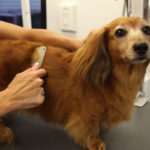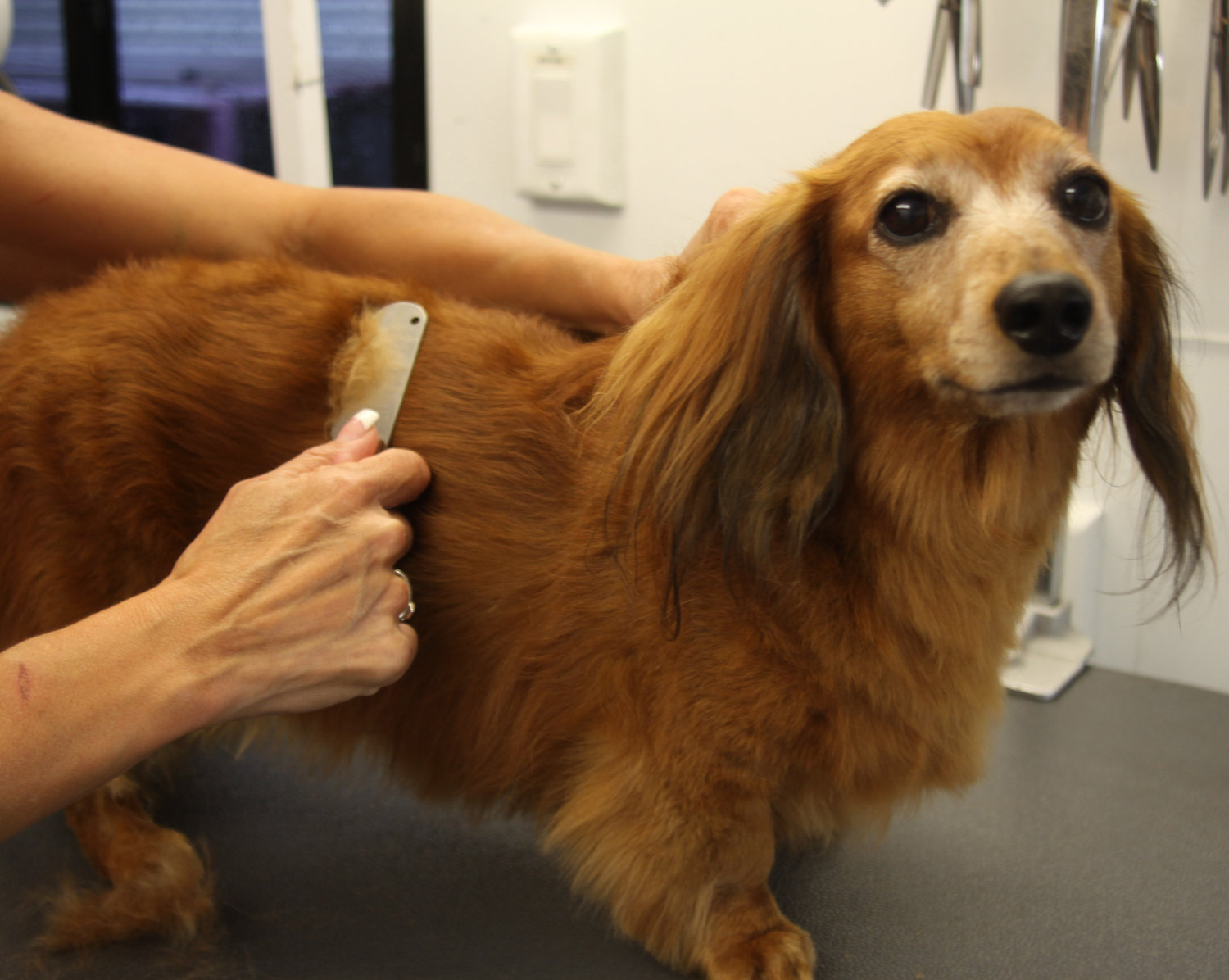Carding mostly can be used on dogs with smooth coats or short, thick coats. If your dog sheds a lot year-round, carding is the best thing to do. On Terriers and Spaniels it’s essential to card out the undercoat to keep the hair follicles more open and prevent skin problems.
Each hair follicle on a human contains one hair. On a dog, each hair follicle contains one primary, or guard, hair (that’s the soft, fuzzy stuff for insulation). If you continually shave off the hair and never card it out, those hair follicles become plugged because the undercoat hairs can’t shed and the hairs become packed when new hairs come in.
Soon the dog gets little bumps and pustules on her skin. If you card the undercoat hairs after you shave the dog, then you are removing some of those undercoat hairs to make room for the new hairs to grow in.
In addition, sometimes when you shave the dog short, the primary hair can get trapped in the hair follicle or slip below the surface, and the undercoat hairs soon fill up the follicle. This leads to skin problems. It’s important to card, brush, and bathe those dead hairs away.
Carding Out the Lumps
If your dog has a lot of undercoat and you shave it, you may notice it looks rather uneven. This is because you didn’t remove the undercoat – you simply cut it short. It’s loose and ready to card out, and carding will smooth out the lumps.
You ne ed to remove undercoat by carding and brushing it out. If you leave it, you end up with a packed coat that is uncomfortable for the dog. This is why brushing and combing your dog is so important. Carding the coat after clipping it smoothes out any unevenness and cleans the hair follicles of dead hair.
ed to remove undercoat by carding and brushing it out. If you leave it, you end up with a packed coat that is uncomfortable for the dog. This is why brushing and combing your dog is so important. Carding the coat after clipping it smoothes out any unevenness and cleans the hair follicles of dead hair.
Carding also helps remove the hair that a brush and comb just can’t get. There are a number of tools you can use for carding.
Carding Tools
You can use a stripping knife or shedding tool. Be gentle when carding so you don’t scrape your dog’s skin. The hair should come out very easily; this will help open up the hair follicles and keep your dog’s skin in top condition. You can card the coat before the bath, but the bath itself may also help remove excess undercoat.
Carding the coat after bathing and drying will finish removing whatever unnecessary coat remains. Carding also helps remove any lines left by your clipper from moving it too fast through the coat.
Don’t Get Carried Away
These tools in the wrong hands can do some damage. The main thing you must remember is not to scrape the skin.
You need to be careful around any lumps, bumps, or warts on the dog’s skin. Periodically check your dog’s skin to make sure you aren’t making it red. Carding takes some practice to get it right, and it’s easy to make mistakes and overdo it, scratching the dog inadvertently.
If you do scratch or irritate the skin, you need to apply a soothing spray such as Eqyss Micro-tek Spray, which is nontoxic and available online at retailers.
The Importance of Carding Dogs
Carding coats is important to many breeds because it helps rid the hair follicles of excess undercoat hairs, which tend to plug up the hair follicle and end up creating blackheads and sores. By keeping the hair follicles unplugged and open, the skin is healthier, and in turn, the hair is healthier as well.
Carding also gets you up close and personal to your dog’s skin and coat. You’ll find any issues sooner rather than later, and you can keep on top of it.
Important!
Your dog can be really enjoying the carding, putting his head in the air and really enjoying the scratch, but when you look closely, you see reddened scratched skin that may even bleed a bit.
It’s easy to use a little too much pressure when you are seeing results. In the case of carding, more is not better. Use short, light strokes all over the dog’s body while holding the skin taut.

